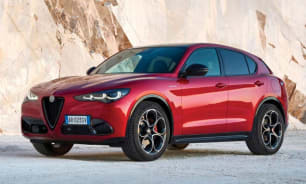Press the PS (Partenza Sportiva) button on the console, slip the manettino control on the steering wheel into ‘Race’ mode, left-foot brake (hard) and floor the throttle. Wait for the PS light on the dash, keep the accelerator pinned and lift off the brake.
Ferrari says the Roma will then proceed to accelerate from zero to 100km/h in 3.4 seconds, and in the interests of a thorough assessment I may have found a quiet light commercial area near Maranello, replicated this procedure and validated the claim.
Yes, even at 1570kg, with 760Nm of pulling power available from 3000-5750rpm, the Roma is exceptionally fast in a straight line. And the twin-turbo V8 that’s been so reserved and docile around town lights up to deliver glorious engine noise and a characteristic exhaust howl.
A flat-plane crank arrangement often makes a vee engine lumpier than a more conventional cross-plane design, but it will rev hard and fast, and in this case the compact size of the Roma’s twin turbos enhances throttle response even further.
Speaking of the turbos, variable boost management helps to smooth acceleration while keeping an eye on fuel economy and despite the flat-plane configuration this engine is perfectly civilised.
A tall top (eighth) gear makes for easy cruising but the tight B-roads and lesser highways we spent most time on didn’t allow for any high autostrada speeds.
But how’s this for a flex? Ferrari says the active rear spoiler will stay in its low-drag position until the car hits 100km/h, then pushing through medium and high drag (135-degree) positions as speed rises. But… “over 300 km/h, the spoiler is always in MD mode because in such conditions it is preferable to have a more balanced car”.
Suspension is by double wishbones at the front with a multi-link set-up at the rear and twin solenoid (magnetic) adaptive dampers all around.
Rubber wrapping the 20-inch forged alloys is top-end Michelin Pilot Sport 4 S (245/35 fr / 285/35 rr) and front-to-rear weight distribution is 50/50.
What that all adds up to is a comfortable, responsive and deeply satisfying drive experience. In standard Ferrari fashion the dual-clutch transmission is rapid-fire perfection, the steering is light but accurate and feelsome, while the in-cabin ergonomics are superb.
Push as hard as you dare in tight, flowing corners and the car just continues to grip and bait you to try harder. And if you do give in and start to run out of talent the ‘Active Yaw Control’ and limited-slip ’E-diff’ will step in to imperceptibly save your bacon.
Moving the manettino through its five positions - ‘Wet’, ‘Comfort’, ‘Sport’, ‘Race’ & ‘ESC-Off’ rapidly transforms levels of ride comfort, steering, transmission and engine response. You can also set the ride to Comfort with other attributes dialled up to 11 for a cross-country sweet spot.
And when it comes to slowing rather than going, the Brembo brake set-up is circuit ready with vented carbon ceramic rotors all around (390mm fr / 360mm rr) clamped by six-piston calipers at the front and four-piston units at the rear. They take a while to warm up, but never feel anything other than mega.

